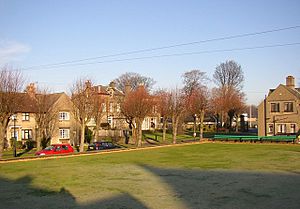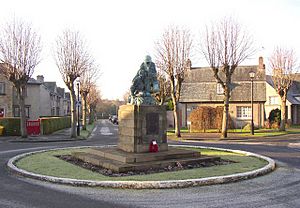Westfield War Memorial Village facts for kids
Westfield War Memorial Village is a special place in City of Lancaster, England. It was started in 1924 to help soldiers, sailors, and airmen, along with their families, after World War I. Today, it still provides homes for 189 people.
Contents
A Special Village for Veterans
After the First World War, many soldiers came home with injuries. People wondered how these brave men and women would support themselves and their families if they couldn't do their old jobs. Newspapers said that the country "owed a debt" to these heroes. This meant people felt it was important to help them.
How the Village Started
Because of strong public support, a group was formed in 1918 at Lancaster Town Hall. Their idea was to build a memorial village at a place called Westfield. This idea came from a famous designer named Thomas Mawson.
In 1919, the Westfield group became a charity. They shared their plans in a brochure, asking for money and planning an opening event. The brochure explained that the village would:
- Be a memorial to the war.
- Have cottages for married soldiers with disabilities.
- Include a hostel (a place to stay) for single soldiers.
- Provide workshops and social areas.
The group also hoped the village would be a good example of town planning for other places. Soldiers from the King's Own Royal Regiment, a local army group, would get the first chance to live there. People wanted to make sure it didn't feel like charity, but a way to thank them. Herbert Storey, who later gave the land for the village, believed it should honor the bravery of all the men and women from Lancaster who served.
Just three weeks after the war ended on November 11, 1918, a big meeting was held at Ashton Hall. People decided that Lancaster needed a lasting memorial for those who died in the war. The Westfield War Memorial Village officially opened on November 27, 1924. The war memorial statue was unveiled two years later, on August 4, 1926. It honored everyone who gave their lives or were injured, especially the men from Lancaster who served in the King's Own Royal Regiment (Lancaster).
Thomas Mawson, a landscape architect from near Lancaster, got the idea for memorial villages from an article. He made the idea even better by suggesting that the villages should not only have homes but also workshops. This was very important because many soldiers' injuries made it impossible for them to go back to their old jobs. The workshops would give them new work.
The War Memorial Statue
The statue in the middle of the village shows one soldier giving water to a wounded friend. This shows how Lancaster recognized the hard work and sacrifices made by its soldiers in the King's Own Royal Regiment. A local artist and teacher named Jennie Delahunt created the sculpture, and it was revealed in 1926.
Westfield Village Today
The Westfield War Memorial Village is still here today. Many people want to live in the houses, and there's often a waiting list. The war memorial statue still stands clearly visible in the center of the village.
The money to build and keep up the village comes completely from donations given by the public. In 1987, the village was rented out to a housing group. This helped get money to make the houses modern. Families of war victims are still given first choice to live there.
Each house in the village has a special plaque outside its front door. These plaques share information about a battle, a person who fought in the war, or a group of people who raised money for that house. The very first house built is named after Herbert Storey, who gave the land for the project.
The many green spaces in the village, like the trees along the streets, the gardens, and the bowling green, represent healing and getting better. Thomas Mawson planned this to help the soldiers recover. Places like the bowling green and the social club were built to help the soldiers rebuild their lives. They were also a way for the people of Lancaster to say thank you.



